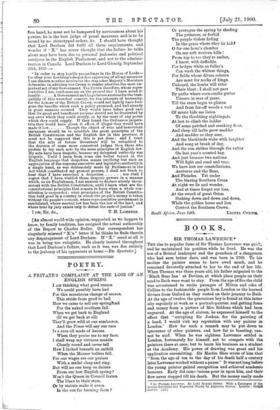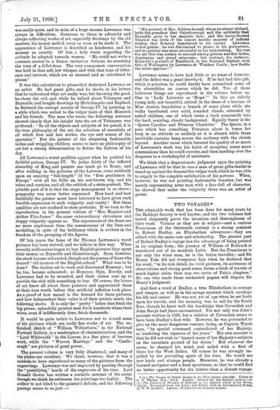BOOKS.
SIR THOMAS LAWRENCE.* THE rise to popular fame of Sir Thomas Lawrence was vie% and he maintained his position while he lived. He was the son of a Bristol innkeeper and the grandson of a clergyman who had seen better days, and was born in 1769. T6 his' mother the painter seems to have owed much, and he remained devotedly attached to her to the end of her life. When Thomas was three years old; his father migrated to:the Black Bear Inn' at Devizes, at which place people on their road to Bath were wont to stay. From the age of five the child was accustomed to recite passages of Milton and .odes of Collins to the fashionable people from London or the learned divines from Oxford as they rested on their journey to Bath. At the age of twelve, the precocious boy is found at-this latter city regularly at work as a portrait-painter, and getting. fame and money from a picture of Mrs: Siddons which had been engraved. At the age of sixteen, he expressed, himself to the effect that "excepting Sir Joshua, for the .painting of a head, I would risk my reputation, with any painter in London." How far such a remark may be put. down to ignorance of other painters, and • how far to boasting, can- not be said. When he was eighteen Lawrence settled in London, fortunately for himself, not to compete with the painters there at once, brit to learn his business as a student . at the Academy. His power of drawing was great and his application unremitting. Sir Martial Shee Wrote of him that "from the age of ten to the day of his death half a- century later Lawrence worked without a pause." It was *Along before the young painter gained recognition 'arid achieved aeadeniie honours. Early did comnissions pour in *Ion Mir, aid their flow never stopped till his death. But. the money easily made • Sir Thomas Lawrence. By Lord Ronal.d..Goiver. With a Catalogue of pie Artists Exhibited and Engraved Works by Algernon Graves. London : Goupll and Co. [LS.] was easily spent, and in spite of a large income Lawrence was always in difficulties. Generous to those in adversity and always oollectind works of art, especially drawings by the old masters, his money melted away as soon as he made it. The appearance of Lawrence is described as handsome, and his manner as courtly. Of him a lady wrote regarding the attitude he adopted towards women. "He could not write a common answer to a dinner invitation without its assuming the tone of a billet -deux. The very commonest conversation was hold in that soft, low whisper, and with that tone of defer- ence and interest, which are so unusual and so calculated to please."
It was this calculation to please that destroyed Lawrence as an artist. He had great gifts, and he shows in his letters that he understood what art really was; but knowing the good, he chose the evil, and while he talked about Velasquez and Reynolds, and bought drawings by Michelangelo and Raphael, he flattered the corrupt society of George IV. by painting in a style which was suited to the vulgar taste of that Monarch and his friends. The man who wrote the following sentence showed clearly that his insight into the art of Velasquez was profound : "In all the objects and subjects of his pencil, it is the true philosophy of the art, the selection of essentials, of all which first and last strikes the eye and senses of the spectator." But the painter of the simpering fashionable ladies and wriggling children seems to have no philosophy of art but a strong determination to flatter the fashion of his day.
All Lawrence's worst qualities appear when he painted his faithful patron, George IV. To judge fairly of the inflated absurdity of Sing and painter one must go to Rome, and after walking in the galleries of the Lateran, come suddenly upon an amazing "full-length" -itf the "flint gentleman in Europe" with all his frills on, his nut-brown wig, and his robes and curtains, and all the rubbish of a state portrait. The pitiable part of it is that the stage management is so clever; pomposity was never better expressed. How hard and how faithfully the painter must have laboured to have given such forcible expression to such vulgarity and vanity ! But these qualities are not confined to state portraits. If turn to the reproduction in the present volume of "Mrs. Maguire and Arthur Fitz-James" the same extraordinary cleverness and sloppy vulgarity oppress us. The expressions of the faces are no more unpleasant than the commonness of the lines and modelling, in spite of the -brilliancy which is evident in the freedom of the grouping of the figures.
Of late years the fame of Sir Thomas Lawrence's worst pictures has been revived; and we believe in this way. When recently Millionaires began to buy English pictures they spent their money on Reynolds and Gainsborough. Soon, however, the stock became exhausted, though not the purses of those who desired "old Masters of the English school." What was to be done P The dealers set to work and discovered Romney; but he, too, became exhausted; so Hoppner, Opie, Beechy, and Lawrence had to be invented, and their values sent up to provide the rich with something to buy. Of course, the lovers of art knew. all about these painters and appreciated them at-their true worth before this artificial inflation took place.. As a proof of how unreal is the demand for these pictures, and how independent their value is of their artistic merit, the following shows. It is only the " pretty " ladies that fetch the big prices; splendidly painted men fetch hundreds where their wives, even if indifferently done, fetch thousands..
It would be Oita unfair to Lawrence not to record some of his pictures which are really fine works of art The un- finished sketch of 'William 'Wilberforce," in the National Portrait Gallery, is a Masterpiece of characterisation, and the 'Lord Whitworth "iii the Louvre. is a fine' piece of bravura yank, while the -"Warren Hastings" and the !` Castle-. reagh".are picture( of great power....
The present volume is very fully illustrated, and many of the plates- are excellent. - We think, however, that it was .a miatake.to have reproduced so ninny of. the .pictures from the engravings. Lawrence-was not improved by passing through the." prettifyitrg '-' hands of the engravers of his time. Lord Ronald Gower has. written a readable account of the artist, thotagl.we think he.estimates his paintings too highly. . . The author is not blind to the-painter's defects, and the following passage seems to us just " His portrait of Mrs. Siddons herself, whom he almost idolised, lacks the grandeur that Gainsborough and the sublithity that Reynolds gave to her majestic face ; and the heavy-browed Thurlow bee little of the almost terrific majesty of judicial wisdom that Romney transferred to his canvas. Lawrence lacked genius ; he was determined to please in his portraiture, and no painter was•more successful in his undertaking. His was the art that was certain to succeed among princes and fine ladies, dignitaries and grand seigneurs; but contrast, for instance, Reynolds's portrait of Heatheeld, in the National Gallery, with that of Wellington by Lawrence at Windsor Castle ; how feeble the latter appears !"
Lawrence seems to have had little or no sense of humour, and the defect was a great drawbar*. If he had had this gift, which is priceless, he could hardly have committed some of the absurdities on canvas which he did. Two of these ludicrous things are reproduced in the volume before us. One is Lady Leicester as 'Hope." In this an elderly young lady, not beautiful, attired in the dress of a heroine of Miss Austen, brandishes a branch of some plant while she walks barefooted over solid, rounded clouds, attended by naked children, one of which turns a back somersault into the hard, resisting, cloudy background. Equally funny is the "Queen Caroline and Princess Charlotte." The Queen, in a pose which has something Pompean about it, tunes her harp in an attitude as unlikely as it is absurd, while those inevitable curtains hang across the archway with the clouds beyond. Another cause which lowered the quality of so much of Lawrence's work was his habit of accepting many more commissions than he could execute, and then handing over the draperies to a workshopful of assistants.
We think that a dispassionate judgment upon the painting of Lawrence will be that he was a man of great gifts unable ta stand up against the demand for vulgar work,which he was able to supply to the complete satisfaction of his patrons. When, however, he was not painting fashionable beauties, but was merely representing some man with a face full of character, he showed that under the vulgarity there was an artist of power.



































 Previous page
Previous page